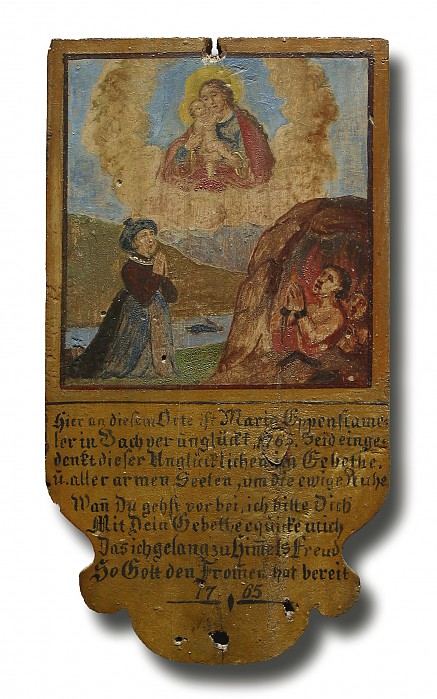Marterl (Wayside Cross)
Here rest the two innocent children ...
Grave plaque for two children
1871
Zinc plate, colored; 37 x 29,5 x 6 cm
At the end of 2010, the Museum for Sepulchral Culture was once again fortunate enough to win an auction for a new piece in its collection. Offered by the auction house as a "grave panel", it is actually an inscription panel made of sheet zinc, as it is known as a component of wrought-iron grave markers from the Alpine region. Such grave markers, which became increasingly widespread from 1700 onwards, usually depicted crosses, with the inscription panel forming the crucifixion point. The auctioned piece is also likely to be from a forged grave cross from the German-speaking south.
The colored panel is hemmed by prongs at the top edge and decorated by a rosette at the top center. The panel is provided with a small door behind which the inscription is located. Its contents are extraordinarily touching, as the death of two children – siblings who never even got to know each other – is mourned:
Here rest the two / innocent children /
Anton Mosner, / who was born /
on June 5, 1870 and / died blessedly on /
April 13, 1871. Jakob Mosner died on July 19, 1871.
on July 19, 1871 / at the age of 7 / .
hours.
The text is continued on the back of the grave plate door, which, however, changes in style and exclusively expresses the parents' sense of grief:
The longing for the two / children, /
All encouragement could not diminish, /
They were victims to them, must pale. /
And much too young let them live; /
To them death struck a deep wound /
To the parents, and from their mouth /
Speaks a feeling of pain; this will / endure, /
Until we see them again on the other side.

The text makes clear that the parents felt the death of their two children as a heavy loss and great suffering. The loss of one's own children in those days was not at all uncommon. Many infants and children died from incorrect or insufficient nutrition or from all kinds of diseases that are nowadays considered terse, but which could not be treated at that time due to the lack of appropriate medication. Even until the beginning of the 20th century, many children died in Europe as a result of unhygienic conditions. Since there was little understanding of antisepsis and not everyone was aware of its importance, many children were at risk of death, for example from infections, shortly after birth, as were many women in childbed. In view of the high infant mortality rate and the much lower life expectancy of people at that time, faith and the associated popular piety were important elements in dealing with strokes of fate, which were to be expected much more frequently in succession at that time. The formulated hope for a reunion in the hereafter, which is explained by the parents on the inscription plaque at the same time as the end point for a sometimes long time of "pain", expresses this clearly. The tomb plaque also takes this into account iconographically, in that the door front is painted with the archangel Raphael and Saint Tobias. Tobias is the main character in the Book of Tobit (Tobias) in the Old Testament. The archangel Raphael takes care of him several times and helps him. Tobias, in turn, trusts Raphael, which is why he becomes the symbol of trust in God and piety. Apart from that, Tobias in Hebrew means: God is good.
Dr. Ulrike Neurath
Arbeitsgemeinschaft Friedhof und Denkmal e.V.
Zentralinstitut für Sepulkralkultur
Museum für Sepulkralkultur
Weinbergstraße 25–27
D-34117 Kassel | Germany
Tel. +49 (0)561 918 93-0
info@sepulkralmuseum.de








